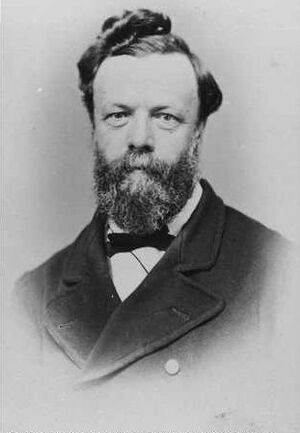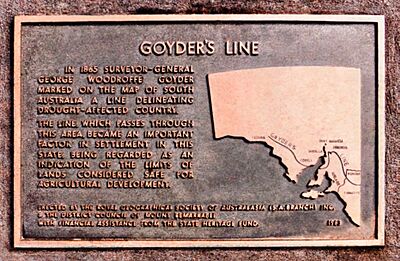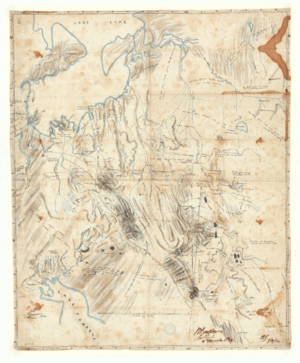George Goyder facts for kids
Quick facts for kids
George Woodroffe Goyder
|
|
|---|---|

George Woodroffe Goyder in 1869
|
|
| Surveyor General of South Australia | |
| In office 31 January 1861 – 30 June 1894 |
|
| Preceded by | Sir Arthur Freeling |
| Succeeded by | William Strawbridge |
| Personal details | |
| Born | 24 June 1826 Liverpool, England |
| Died | 2 November 1898 (aged 72) Mylor, South Australia |
| Resting place | Stirling District Cemetery |
| Spouses |
Frances Mary Smith
(m. 1851; died 1870)Ellen Priscilla Smith
(m. 1871) |
| Children | 12 |
| Parents |
|
| Relatives | Edwin Mitchell Smith (nephew) |
| Occupation | Surveyor |
George Woodroffe Goyder (born June 24, 1826 – died November 2, 1898) was an important surveyor in the Colony of South Australia during the late 1800s. He quickly became a key figure in the government.
By 1861, he was named the Surveyor General of South Australia. Today, he is best known for "Goyder's Line of rainfall." This line helped farmers know where they could grow crops. He also helped plan and set up Darwin, which is now the capital of the Northern Territory. Goyder explored much of South Australia and gave advice to many new settlers.
Contents
George Goyder's Career
Early Life and Education
George Goyder was born in Liverpool, England. His father, David George Goyder, was a minister and doctor. George moved to Glasgow with his family. There, he worked for an engineering company and studied surveying.
In 1848, when he was 22, Goyder moved to Sydney, Australia. He worked for a company that sold things at auctions. In 1851, he moved to Adelaide. He found a job as a draftsman for the government.
Rising Through the Ranks
Around 1856, Goyder became the Assistant Surveyor-General. During this time, he went on many trips into the remote areas of South Australia. He thought the lakes he saw had fresh, lasting water. However, he later learned the water levels changed a lot. He wrote many letters to new farmers who had moved to dry northern areas. He also surveyed the new mining areas in the Flinders Ranges.
In 1861, Goyder was appointed Surveyor-General. His first years in this role were tough. He worked to help settle the Northern Territory. He oversaw the creation of large farming areas for cattle. Farmers faced a big drought in the mid-1860s. Many had to move their families away from their cattle stations. Goyder also faced personal sadness. His wife, Frances Mary Smith, lost twins during his long trips.
Goyder retired as Surveyor-General in 1894. He had worked for the public service for 41 years.
What Was Goyder's Line?

Before the drought of the mid-1860s, farmers were growing wheat and barley further north. Many believed that rain would "follow the plough." This meant they thought farming would bring more rain. So, they expected to grow crops all the way to the Northern Territory border.
But the drought of 1864–65 changed these ideas. Goyder was asked to study the problem. He found out how far south crops had failed. He marked the furthest points inland where crops had not failed. This line was called the "Line of Rainfall." It roughly matched areas that received about 300 millimeters (12 inches) of rain each year.
Goyder advised farmers not to grow cereal crops outside this line. Many people thought his idea was strange. They were very hopeful about farming everywhere. But after farmers lost a lot of money near or outside the line, Goyder's advice proved correct. This was especially true during the droughts of 1881–1882 and 1884–1886. Many droughts since then have shown he was right.
Goyder's Line became widely accepted after several dry years. Newer farming methods have allowed some farming beyond the line since the 1980s.
Planning the City of Palmerston (Darwin)
The government of South Australia sent Goyder to plan a new capital city. The Northern Territory was part of South Australia at that time. The new city was to be named Palmerston. Goyder chose the site because it had good water and was easy to reach by land or sea. This site was chosen after an earlier choice at Escape Cliffs was rejected.
Goyder and his team of about 128 men left Port Adelaide on December 27, 1868. They arrived in Darwin Harbour on February 5, 1869. He chose the spot on Fort Point near Port Darwin. He also planned nearby towns called Daly, Southport, and Virginia. They finished planning all four sites in 18 months.
Goyder returned to Adelaide in November 1869 with about 30 men. Most of his team returned in October 1870. However, many stayed to work in the new town. Goyder's expedition included about 100 people. Many streets and places in Darwin are named after them.
Soon after, the Overland Telegraph cable from England reached Palmerston. It started working in 1872. In 1911, Palmerston was renamed Darwin. Around 1980, the name Palmerston was used again for a new city near Darwin.
George Goyder's Family Life
George Goyder married Frances Mary Smith on December 10, 1851. They had nine children together. Frances died on April 8, 1870. George then married her sister, Ellen Priscilla Smith, on November 20, 1871. Ellen had been helping care for the children. With Ellen, George had three more children.
Goyder lived a strict and disciplined life. He was firm with his staff, but people always saw him as fair. Even though farmers often complained, he gave them good advice. By the late 1880s, Goyder's health was getting worse. He resigned as Surveyor-General at the end of 1893. He died at his home in Mylor on November 2, 1898. He was buried in the Stirling District Cemetery.
What is Named After George Goyder?
Goyder Road in Darwin is named after him. Many other members of his team are also honored with names. A large river in Arnhem Land and election areas in the Northern Territory and South Australia are named for him. Mount Woodroffe, the highest mountain in South Australia, is named after his middle name, Woodroffe.
Other things named after Goyder include a type of grasswren bird called Amytornis goyderi. There is also a local council, a new building at the Royal Adelaide Showgrounds, several streets, a park, and the Goyder Institute for Water Research.
Places Named by Goyder
- Fannie Bay, Northern Territory
- Frances Bay, Northern Territory
Places Named After Goyder
- Goyder's Line of rainfall
- Regional Council of Goyder
- Electoral district of Goyder, South Australia
- Electoral division of Goyder, Northern Territory
- Goyder Lagoon
- Goyder Channel
- Goyder crater
- Goyder Highway (State B64), South Australia
- Goyder River in East Arnhemland, Northern Territory
- Goyder, South Australia, a town
- Woodroffe, a suburb of Palmerston
- Mount Woodroffe, South Australia's highest peak
See also
- Agriculture in Australia
- Moonta Herald


